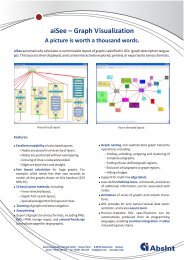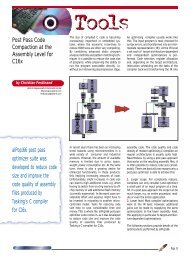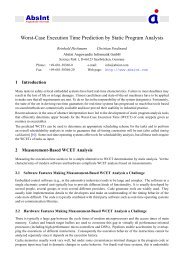5 Graph Description Language (GDL) - Absint
5 Graph Description Language (GDL) - Absint
5 Graph Description Language (GDL) - Absint
You also want an ePaper? Increase the reach of your titles
YUMPU automatically turns print PDFs into web optimized ePapers that Google loves.
maxdepth and maxdepth do not provide satisfying results. maxdepthslow tries to increase<br />
the depth of the layout and mindepthslow the width of the layout.<br />
– maxindegree / minindegree<br />
maxindegree schedules nodes with a maximum of incoming edges first, i. e. these<br />
nodes are positioned early. minindegree schedules nodes with a minimum of incoming<br />
edges first.<br />
– maxoutdegree / minoutdegree<br />
maxoutdegree schedules nodes with a maximum of outgoing edges first, i. e. these<br />
nodes are positioned early. minoutdegree schedules nodes with a minimum of outgoing<br />
edges first.<br />
– maxdegree / mindegree<br />
maxoutdegree schedules nodes with a maximum of the sum of incoming and outgoing<br />
edges first, i. e. these nodes are positioned early. The algorithm minoutdegree schedules<br />
nodes with the minimum of the sum of incoming and outgoing edges first.<br />
– minbackward<br />
Instead of calculating strongly connected components, minbackward performs a topological<br />
sorting to assign ranks to the nodes. This algorithm is fast if the graph is acyclic.<br />
– tree<br />
The tree algorithm is a specialized method for downward laid out (see p. 117). It is<br />
very fast for these tree-like graphs and results in a balanced layout.<br />
– forcedir<br />
This layout algorithm computes a force-directed placement. It is a nonhierarchical<br />
layout method that works well for undirected graphs. Some features of hierarchical<br />
layout like near edges are disabled for this layout algorithm.<br />
The layout calculation for this algorithm can be controlled via the following graph<br />
attributes:<br />
∗ Spring embedder forces<br />
attraction (p. 66), repulsion (p. 82)<br />
∗ Gravitational forces<br />
gravity (p. 72)<br />
∗ Simulated annealing<br />
fdmax (p. 71),<br />
tempmin, tempmax (p. 86),<br />
temptreshold (p. 87), tempscheme (p. 87), tempfactor (p. 86)<br />
∗ Random influence<br />
randomfactor (p. 81), randomrounds (p. 82), randomimpulse (p. 82)<br />
∗ Magnetic forces<br />
magnetic_field1, magnetic_field2 (p. 79),<br />
magnetic_force1, magnetic_force2 (p. 79)<br />
∗ Energy level<br />
energetic (p. 70)<br />
77





